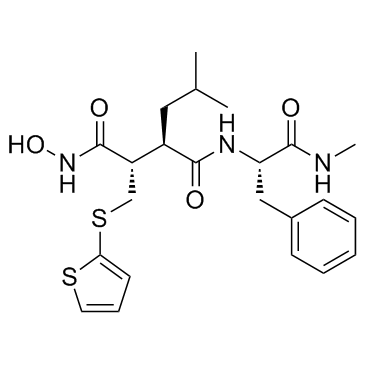巴马司他

巴马司他结构式

|
常用名 | 巴马司他 | 英文名 | Batimastat |
|---|---|---|---|---|
| CAS号 | 130370-60-4 | 分子量 | 477.640 | |
| 密度 | 1.3±0.1 g/cm3 | 沸点 | N/A | |
| 分子式 | C23H31N3O4S2 | 熔点 | 236-238° | |
| MSDS | 中文版 美版 | 闪点 | N/A |
|
The sorting protein PACS-2 promotes ErbB signalling by regulating recycling of the metalloproteinase ADAM17.
Nat. Commun. 6 , 7518, (2015) The metalloproteinase ADAM17 activates ErbB signalling by releasing ligands from the cell surface, a key step underlying epithelial development, growth and tumour progression. However, mechanisms acutely controlling ADAM17 cell-surface availability to modulat... |
|
|
Inside-out Regulation of Ectodomain Cleavage of Cluster-of-Differentiation-44 (CD44) and of Neuregulin-1 Requires Substrate Dimerization.
J. Biol. Chem. 290 , 17041-54, (2015) Ectodomain shedding of transmembrane precursor proteins generates numerous life-essential molecules, such as epidermal growth factor receptor ligands. This cleavage not only releases the regulatory growth factor, but it is also the required first step for the... |
|
|
Prevention of abdominal aortic aneurysm progression by targeted inhibition of matrix metalloproteinase activity with batimastat-loaded nanoparticles.
Circ. Res. 117 , e80-9, (2015) Matrix metalloproteinases (MMPs)-mediated extracellular matrix destruction is the major cause of development and progression of abdominal aortic aneurysms. Systemic treatments of MMP inhibitors have shown effectiveness in animal models, but it did not transla... |
|
|
Activation of the P2X7 receptor induces the rapid shedding of CD23 from human and murine B cells.
Immunol. Cell Biol. 93(1) , 77-85, (2015) Activation of the P2X7 receptor by the extracellular damage-associated molecular pattern, adenosine 5'-triphosphate (ATP), induces the shedding of cell surface molecules including the low-affinity IgE receptor, CD23, from human leukocytes. A disintegrin and m... |
|
|
Simulated physiological stretch-induced proliferation of human bladder smooth muscle cells is regulated by MMPs.
Arch. Biochem. Biophys. 564 , 197-202, (2014) Mechanical stimulation is an essential factor for organisms to develop normally. In bladder development matrix metalloproteinases (MMPs) play an important role through structure remodeling and regulating the cell proliferation. In this study, we investigated ... |
|
|
MMP regulation of corneal keratocyte motility and mechanics in 3-D collagen matrices.
Exp. Eye Res. 121 , 147-60, (2014) Previous studies have shown that platelet derived growth factor (PDGF) can stimulate corneal keratocyte spreading and migration within 3-D collagen matrices, without inducing transformation to a contractile, fibroblastic phenotype. The goal of this study was ... |
|
|
A colorimetric-based amplification system for proteinases including MMP2 and ADAM8.
Anal. Biochem. 484 , 75-81, (2015) We have developed a new amplification system for proteinases that is sensitive, simple, and inexpensive to run, exemplified by a horseradish peroxidase (HRP)-conjugated, dual MMP2 (matrix metalloproteinase 2) and ADAM8 (a disintegrin and metalloproteinase 8) ... |
|
|
Flightless I interacts with NMMIIA to promote cell extension formation, which enables collagen remodeling.
Mol. Biol. Cell 26 , 2279-97, (2015) We examined the role of the actin-capping protein flightless I (FliI) in collagen remodeling by mouse fibroblasts. FliI-overexpressing cells exhibited reduced spreading on collagen but formed elongated protrusions that stained for myosin10 and fascin and pene... |
|
|
Shedding of dipeptidyl peptidase 4 is mediated by metalloproteases and up-regulated by hypoxia in human adipocytes and smooth muscle cells.
FEBS Lett. 588(21) , 3870-7, (2014) Dipeptidyl peptidase 4 is an important drug target for diabetes and a novel adipokine. However, it is unknown how soluble DPP4 (sDPP4) is cleaved from the cell membrane and released into the circulation. We show here that MMP1, MMP2 and MMP14 are involved in ... |
|
|
S100A4 regulates migration and invasion in hepatocellular carcinoma HepG2 cells via NF-κB-dependent MMP-9 signal.
Eur. Rev. Med. Pharmacol. Sci. 17(17) , 2372-82, (2013) We previously showed that the calcium-binding protein S100A4 is overexpressed and related to metastasis in hepatocellular carcinoma (HCC). However, whether S100A4 participates in the regulation of metastasis and its mechanisms in HCC is mostly unknown. Given ... |